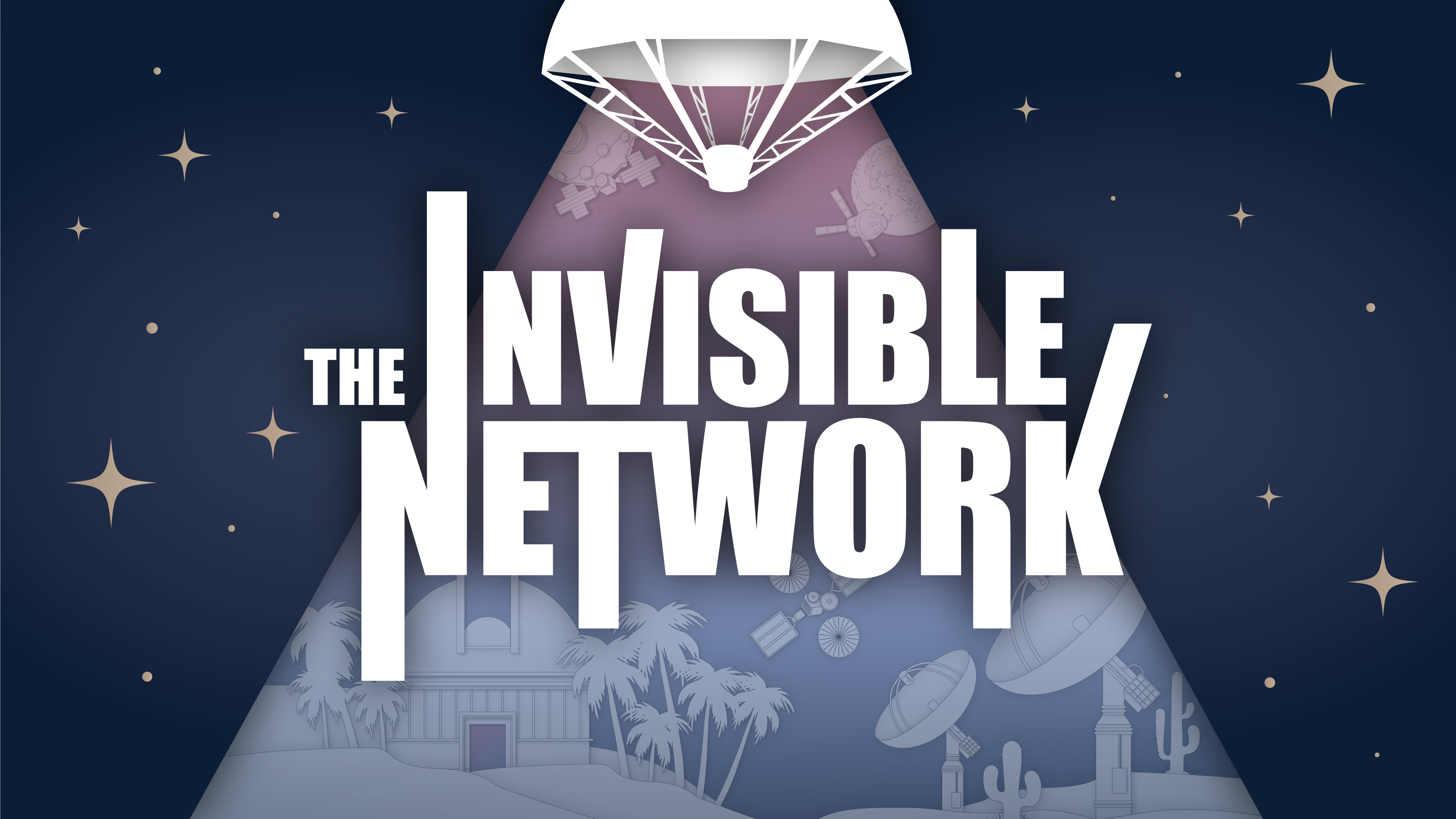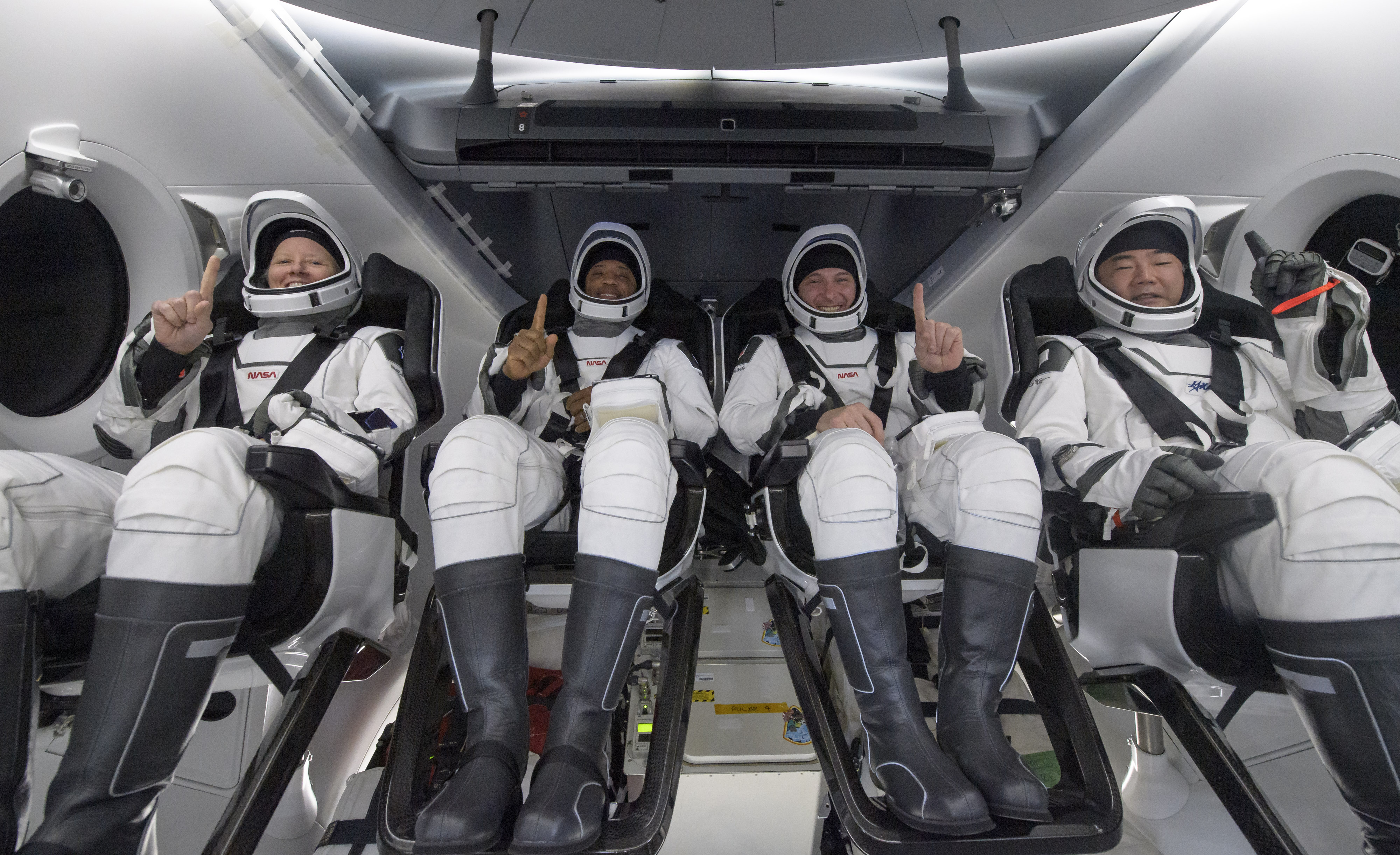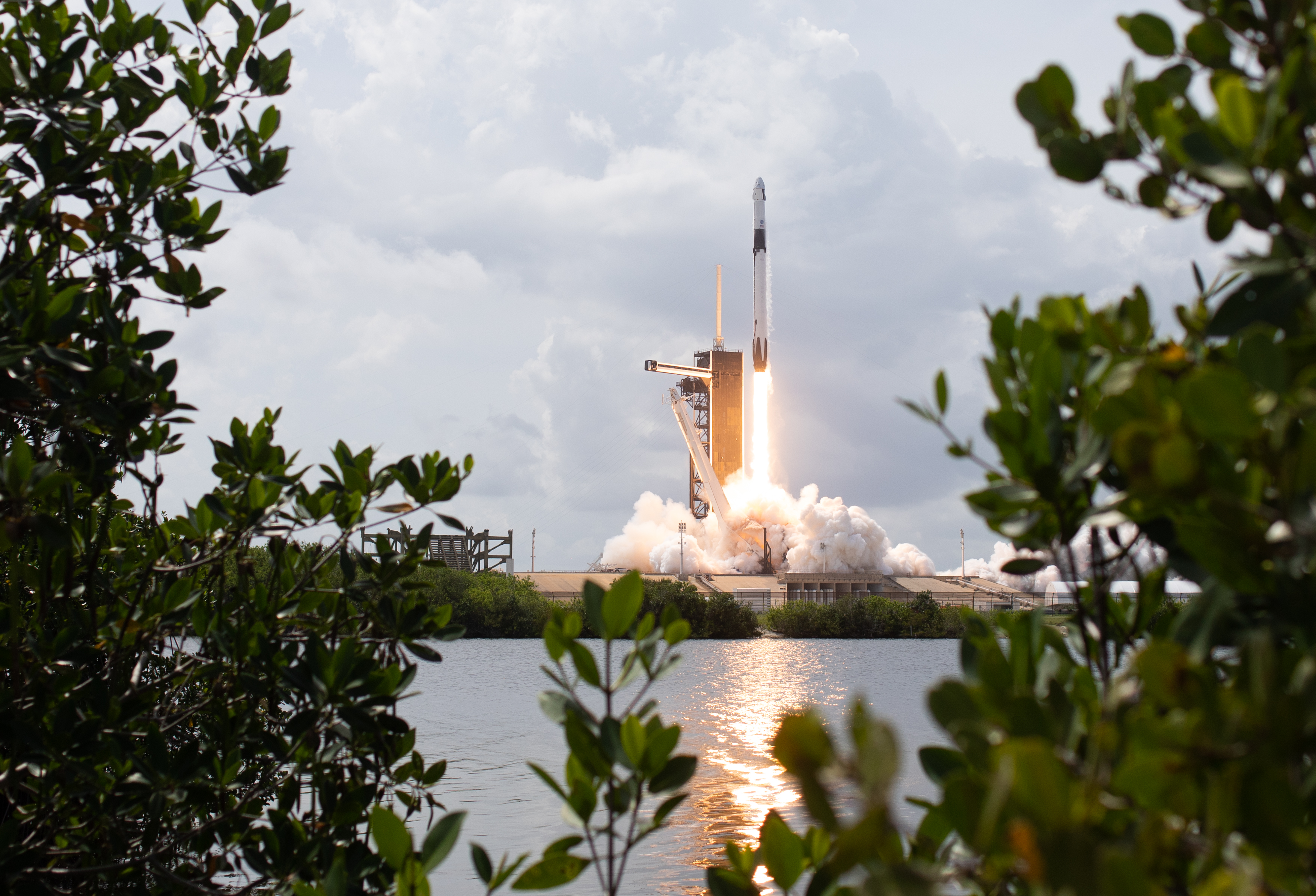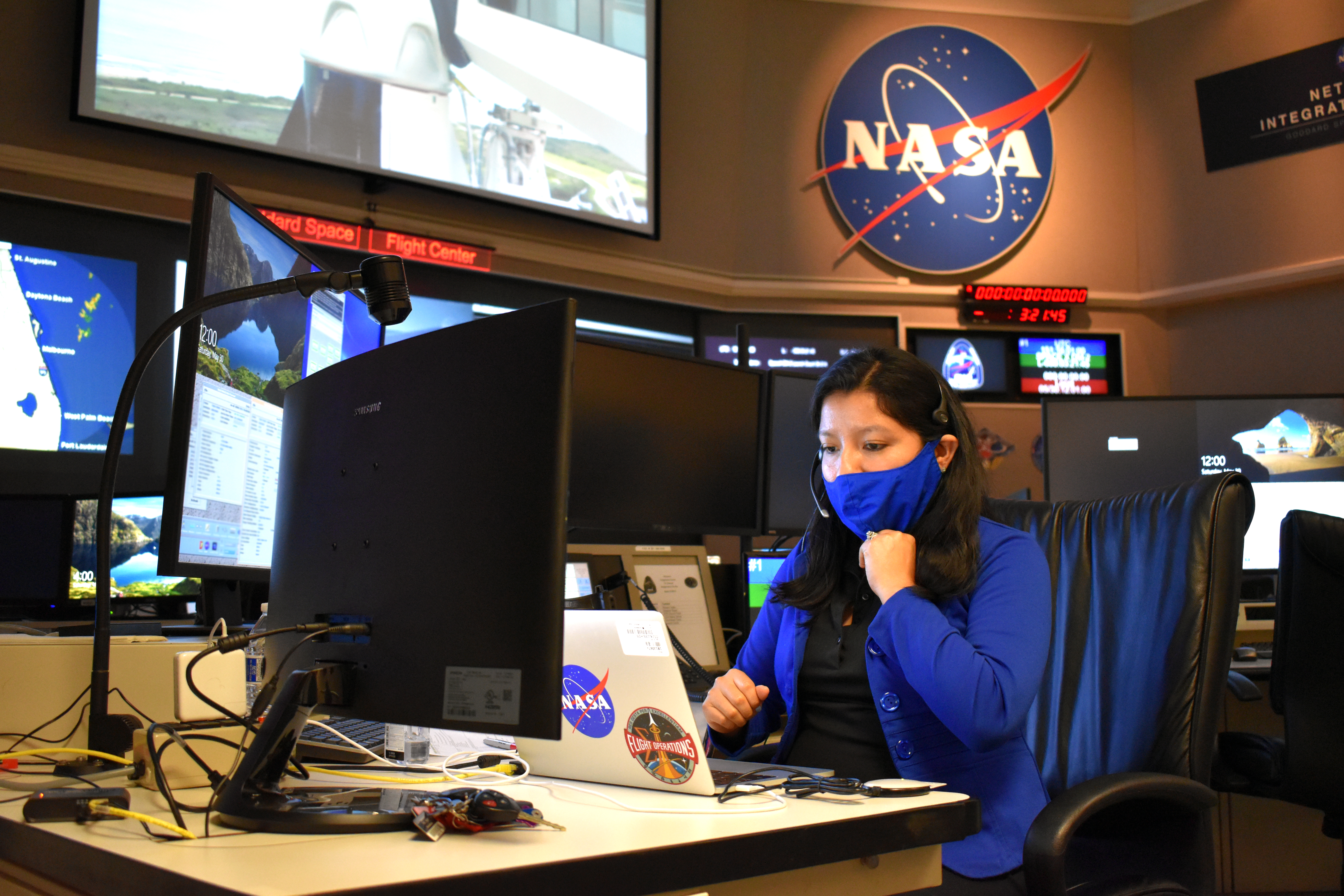

MISSION CONTROLLER 1
And SpaceX we still [have a] nominal descent rate. 200 meters. Brace for splashdown.
MISSION CONTROLLER 2
SpaceX copies. Brace for splashdown.
…
NARRATOR
Last week, NASA’s SpaceX Crew-1 mission returned from the International Space Station. The SpaceX Crew Dragon undocked from the orbiting laboratory, descended through the atmosphere, unfurled its parachutes, and gently splashed down off the coast of Florida. The mission returned NASA astronauts Michael Hopkins, Victor Glover and Shannon Walker, and JAXA astronaut Soichi Noguchi home to Earth after a nearly six-month stay in space.
The momentous return of this mission comes just days after the launch of Crew 2, another SpaceX Commercial Crew Program mission to the station. The Crew-2 mission sent NASA astronauts Shane Kimbrough and Megan McArthur, JAXA astronaut Akihiko Hoshide, and European Space Agency astronaut Thomas Pesquet to the space station.
Soon, NASA and the Boeing company will launch Orbital Flight Test-2, or OFT-2, the latest test of the company’s CST-100 Starliner spacecraft. This critical milestone brings Boeing one step closer to becoming the second commercial company with the ability to send crewed missions to the space station, joining SpaceX and their Crew Dragon spacecraft.
With all this activity, it’s hard to remember that just a decade ago, commercial human spaceflight was just a dream. In fact, NASA’s Commercial Crew Program just celebrated its 10-year anniversary on April 5. Today, NASA and companies like SpaceX and Boeing have made that dream a reality, heralding the beginnings of a commercial space economy.
And crewed missions to the space station are just the beginning.
I’m Danny Baird. This is the Invisible Network.
…
NARRATOR
When Space Shuttle Program concluded in 2011, NASA no longer possessed a human-rated vehicle capable of ferrying crew to the International Space Station, our hub for microgravity research in low-Earth orbit. In the absence of this critical capability, NASA had to rely exclusively on the Russian Soyuz spacecraft, launching astronauts from the Baikonur Cosmodrome in Kazakhstan.
PHIL MCALISTER
For almost a decade, we had to purchase seats on the Russian Soyuz vehicle to get our astronauts up and down to the International Space Station. The Russians have been very good partners — the Soyuz has turned out to be an extremely safe and reliable vehicle — so that’s all been good. But we lacked a domestic capability to transport humans into space, and that was a strategic capability that the United States wanted.
NARRATOR
Phil McAlister serves as the director of NASA’s Commercial Spaceflight Division. He joined NASA about 15 years ago from the private sector, lending his expertise in commercial spaceflight capabilities to then-administrator Michael Griffin. Today, his portfolio includes the Commercial Crew and Cargo Program, which he helped to shepherd from infancy to the exciting and robust program that we see today.
PHIL MCALISTER
If I had started five years earlier, I don’t think there would have been a whole lot there. I hit the timing just right, where the industry was maturing and NASA was starting to look for commercial capabilities and then I came to work at NASA. Kind of all those thinks kind of came together at the right time.
NARRATOR
To establish the next generation of crewed spacecraft for missions to low-Earth orbit, NASA turned to the commercial marketplace, focusing the agency’s efforts on the unique challenges of deep space exploration.
PHIL MCALISTER
Transporting humans to low-Earth orbit: it didn’t really require pushing the state of the art. It’s hard. It’s one of the hardest things we do as a nation — transporting people to space — but we didn’t need any technological breakthroughs. We needed just good, sound engineering. We also saw that there was a potential non-NASA market for human space transportation — commercial human space transportation — space tourism — that was seen to be the big one — but other people had ideas for microgravity services in space. And so we saw a possibility of a non-NASA market.
NARRATOR
The model that NASA pursued was far different from any the agency had pursued for previous human spaceflight missions. The agency gave companies selected to develop these capabilities unprecedented freedom and autonomy. NASA still provided oversight and expertise, but these crewed vehicles are unique products of Boeing and SpaceX.
PHIL MCALISTER
Our private sector partners: very focused on speed and cost effectiveness. NASA: focused on safety and reliability. And you bring those two together, we had a very powerful combination, or partnership…
To allow the private sector the ability to determine how they were going to build these systems, they made the decision on what launch vehicle they wanted — what kind of spacecraft, what kind of propulsion, what kind of tanks, structures, things like that — pushing that off to the private sector and then just managing at a higher level of requirements.
For the space shuttle, we had between 10 and 12,000 requirements, all the way down to how much stainless steel was in the bolts that were used in the shuttle. For Commercial Crew, we had 300, so two orders of magnitude less. And what that does is it opens up the trade space for your commercial partner to really innovate and do things in a more cost effective fashion.
NARRATOR
Just how cost-effective are the vehicles they developed? Enormously so.
PHIL MCALISTER
So, I think the biggest difference in the systems that came out were our systems are very, very cost effective with commercial crew. The latest seat price for the Soyuz purchase was about 90 million dollars per seat. And when we originally let the Commercial Crew contract, we averaged up the two companies and made some assumptions and it came out to 58 million dollars a seat, so almost a third less. Every time we buy a seat, it’s going to be less and that’s money that we can put into our deep space mission. And so, it really is just a win-win for everybody.
NARRATOR
Looking to the future, Phil imagines that the same cost-effectiveness offered to NASA will empower other companies to develop capabilities and services in low-Earth orbit. It will become more and more common for individuals outside the agency to visit space, buying tickets from the same companies that NASA uses to transport our astronauts.
PHIL MCALISTER
Now, it’s a very expensive ticket, so you’re going to have to be very, very wealthy. But that’s what all modes of transportation — new modes of human transportation — they start off very, very expensive. And then over time, as entrepreneurs and business people enter the market, you see costs come down.
And that’s what our hope is for [the] Commercial Crew Program. We can now use it. It’s cheaper for us to buy the seats than it is to purchase the Soyuz seats, which is a real strong testament to U.S. private industry…
So, not only does it help NASA, we think it helps the United States. And I don’t think it’s a stretch to say it helps all of humanity. Anybody can now, for the first time, buy a ticket to space from a private company. And it’s amazing.
…

ANNOUNCER
10… 9… 8… 7… 6… 5… 4… 3… 2… 1… 0…
Ignition. Liftoff of the Falcon 9 and Crew Dragon. Go NASA. Go SpaceX. Godspeed, Bob and Doug.
…
NARRATOR
On Saturday, May 30, 2020, a SpaceX Crew Dragon spacecraft launched from the historic Launch Complex 39A at NASA’s Kennedy Space Center in Florida to the International Space Station. This was SpaceX’s second demonstration mission under the Commercial Crew Program, and the first mission to launch American astronauts from American soil to the station since the shuttle program. The Crew Dragon ferried NASA astronauts Robert Behnken and Douglas Hurley to join the Expedition 63 crew aboard the space station.
On that day, I joined millions watching live coverage of the SpaceX Demo-2 mission on NASA TV. It was an incredible milestone to behold, the first-ever commercial flight of astronauts to the space station.
For me, it was also a work day. I sat on my couch, monitoring social media and receiving updates from the Near Space Operations and Control Center, or NSOCC, at NASA’s Goddard Space Flight Center in Greenbelt, Maryland. There, NASA communications and navigation professionals empowered the mission with critical services necessary to launch and dock with the space station.
ROSA AVALOS-WARREN
I call myself very lucky to have had the opportunity to work on the first crewed test flight as the mission manager for DM-2. So, where we experienced — you know — a new era of human spaceflight.
NARRATOR
Human Space Flight Communications and Tracking Network Mission Manager Rosa Avalos-Warren, alongside then-Network Director Neil Mallik, oversaw network services from the NSOCC, a hub for NASA’s Near Space Network services. Throughout launch day, I received photos of her to share on social media. She wore a blue mask, diligently monitoring network systems from a suite of monitors to ensure the success and safety of Demo-2.

ROSA AVALOS-WARREN
So, as part of Goddard and [the] Human Space Flight Communications and Tracking Network, we integrate the network elements into comprehensive services for crewed and also commercial cargo missions. So, by coordinating with these different network elements, we provide data and voice communication between the crew and the spacecraft. And so, working with the different teams to make ensure that we track the spacecraft accurately. And then, in case of an emergency, we collaborate with the Eastern Range — part of the U.S. Space Force — to perform independent ground-based orbit determination in the event of non-nominal operation conditions, so we’re always ready for any type of contingency operations. And alongside of that, integrating the search and rescue team, which helps provide responsive location services.
NARRATOR
Launch communications services provided to both the Boeing Starliner and the SpaceX Dragon are pretty similar. Navigation engineers at Goddard’s Flight Dynamics Facility track the spacecraft on their ascent, leveraging years of experience and technology development supporting the navigation needs of crewed missions. The Search and Rescue team monitors emergency beacons on the spacecraft in the event of a launch abort or other contingencies.
Primary voice and data communications are handled by NASA’s constellation of Tracking and Data Relay Satellites, or TDRS. These spacecraft relay communications between the crewed vehicles and mission controllers across the country via terrestrial connections with TDRS ground stations in Las Cruces, New Mexico, and Guam, a U.S. territory in the Pacific Ocean.
TDRS, as the primary communications provider to the International Space Station, is central to the services provided. All spacecraft visiting the orbiting laboratory need TDRS services to successfully complete their missions.
DEREK OTERMAT
And it’s a standard service that we provide a lot of our human spaceflight customers, like a lot of the cargo… providers like Northrop Grumman with Cygnus and SpaceX has their own cargo flights. They provide the same TDRS services, it’s just a different mission.
NARRATOR
Derek Otermat serves as the Deputy Network Director for Human Spaceflight, having recently been promoted to that role from mission manager. But, prior to joining NASA, Derek worked on the commercial side of the Commercial Crew Program.
DEREK OTERMAT
So, I started out in 2008 working the [space station] program as an RF, [radio frequency,] test engineer for their S-band communications system that actually talked to TDRS, so I’ve always had a rich background in RF communications and… the services that Goddard oversees… And then in 2012, I became actually a Starliner employee for Boeing, but I was the lead ground communications implementation engineer, doing all the terrestrial communications between… the Boeing Control Center in Houston and at Kennedy where it launches… We wore multiple hats — so I was also an RF test engineer.
NARRATOR
Having experience on both sides of the Commercial Crew Program equation gives Derek a unique perspective.
DEREK
So, I understand the programmatics and the design process… from both a commercial perspective and a government perspective. So, I understand like all the different lifecycle reviews… all the different reviews that the spacecraft designers have to go through… but, I also understand the design of the spacecraft as well, from a technical perspective. So like, in communications systems… there’s always two people involved: so you get the person providing it, and you got the spacecraft receiving it, and both have to be properly configured for it to work properly.
NARRATOR
The services our engineers provide are crucial components of crewed missions to the space station. The work of communications engineers like Rosa and Derek is helping lift these American companies to new heights while fueling the commercial space economy.
…
NARRATOR
As I watched the SpaceX Demo-2 mission ascend to the space station, I had no idea the incredible commercial transformation my own program would undergo over the following months. The Space Communications and Navigation program is in the midst of a foundational shift, where NASA turns to U.S. private industry to provide the bulk of its space communications services.
Over the next two episodes of the podcast, we’ll take a look at efforts to grow a commercial space communications marketplace in near-Earth space. We’ll also look at the ways that commercial industry will help NASA provide communications services to lunar missions, as NASA establishes a sustained presence at the Moon with the Artemis program.
Just as the Commercial Crew Program has fundamentally changed the paradigm for crewed missions to low-Earth orbit, nurturing a space communications marketplace will revolutionize the way NASA provides critical communications and navigation services.
Stay tuned.
…
NARRATOR
This commercialization-focused season of “The Invisible Network” debuted in May of 2021. Our next season will focus on the Laser Communications Relay Demonstration and debut after the launch of the mission later this year.
The podcast is produced by the Space Communications and Navigation program, or SCaN, out of Goddard Space Flight Center in Greenbelt, Maryland. Episodes were written and recorded by me, Danny Baird, with editorial support from Katherine Schauer. Our public affairs officers are Lora Bleacher of Goddard’s Office of Communications and Kathryn Hambleton of the Human Exploration and Operations Mission Directorate.
Special thanks to Barbara Adde, SCaN Policy and Strategic Communications director, Rob Garner, Goddard Web Team lead, and all those who have leant their time, talent and expertise to making “The Invisible Network” a reality. Be sure to rate, review, and follow the show wherever you get your podcasts. For transcripts of the episodes, visit NASA.gov/invisible. To learn more about the vital role that space communications plays in NASA’s mission, visit NASA.gov/SCaN. And for more NASA podcast offerings, visit NASA.gov/podcasts.


























